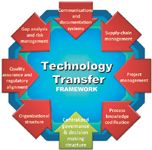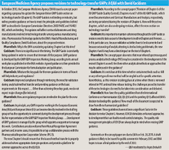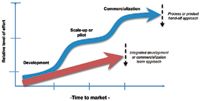Keys to Executing a Successful Technology Transfer
The authors highlight the need for a technology-transfer process that is efficient, cost-effective, and repeatable, stressing the importance of process understanding. Read this and other preferred organization articles in this special issue.
This article is part of a special issue on Preferred Providers.
Pharmaceutical manufacturers conduct more technology transfers now than ever before, yet technology transfer remains far from a core competency in the industry today, according to a recent survey conducted by Tunnell Consulting. Looking at the technology-transfer practices of executives at 10 global pharmaceutical companies, the study found that most companies undertake more than 10 technology transfers per year-whether from development to commercial manufacturing or from one manufacturing site to another-and some execute many more. Yet despite the frequency of transfers, the survey results showed the following problems:
- Corporate decision-makers make technology-transfer plans primarily on the basis of financial and marketing considerations, failing to take into account early enough in the decision-making process the effect that execution will have on the organization.
- Senior management significantly underestimates the need for resources and scheduling because its members lack sufficient first-hand knowledge and input from the organization regarding the organizational requirements for supporting technology transfers at the sending and receiving sites, as well as for the numerous support functions that are integral to the process.
- Once high-level decisions have been made, implementation is left in the hands of individual departments, functions, or sites with little, if any, high-level centralized oversight, control, or appropriate metrics.
- The lack of early and effective coordination between the sending and receiving sites, or between development and manufacturing, is further complicated by the absence of clearly defined roles and responsibilities for individuals and teams, lack of open communications, and poor visibility of timelines, progress, and results.
- The transfer runs into problems because a thorough and detailed assessment has not been conducted regarding the comparability between the sending and receiving sites' equipment, environments, and supply chains.
- The participating organizations fail to clearly identify, define, and agree upon which standards and procedures will be followed while conducting transfers, including assurance that all required documentation will be completed in an accurate, timely, and compliant manner.
- The organization fails to take into proper account the impact that technology transfers will have on functions, such as quality, regulatory, laboratory, and supply chain.
- Poor process understanding, coupled with incomplete documentation (i.e., codification) of all the required process parameters, results in attempts to transfer products and processes not under a sufficient and defensible level of control, leading to poor manufacturability at the receiving site.
The adverse consequences of these common mistakes in the planning and implementation of technology transfer include budget and schedule overruns, disruption of both the sending and receiving organizations, compliance problems, excessive rejects and rework, slower time to market, and supply unreliability. In today's life-sciences business environment, companies can no longer afford such mistakes. They need a technology-transfer process that, like any process, is efficient, cost-effective, sustainable, and repeatable-a core competency that consistently produces maximum strategic impact. Although the components of such a comprehensive technology-transfer capability are many, they can be reduced to two essentials: an overarching technology-transfer framework and rigorous process understanding before transfer. Companies that achieve those two objectives will not only avoid the common mistakes in technology transfer, but also transform the process into a formidable competitive advantage.
The overarching framework
Figure 1: A technology-transfer framework depicting some of the major capabilities and support systems that need to be in place to support technology transfer. (FIGURES ARE COURTESY OF THE AUTHORS)

Technology transfer encompasses a broad range of activities that must be properly managed for effective, efficient completion. It begins with the end: a definition of when transfer can be considered successful and complete. Technology transfer should be defined as complete when the process is operating in a reliable (i.e., predictable) manner within the established specifications at the receiving site. With this objective in view, an overall framework (see Figure 1) in which that goal can be achieved should include the following ideas.
An overall transfer-program-management process. This process includes a governance structure, the establishment of executive sponsorship, and the clear delineation of roles and responsibilities-including the roles of all support functions, such as quality or regulatory-for all transfers. This program-level process enables a company to manage its technology transfers as a portfolio, apply risk-management techniques to the portfolio as a whole, and optimize the return on investment.
A project-level management for the transfer of each product or process. This includes a "by design" set of requirements, activities, decision points, milestones, and best practices that ensure timely, well-documented transfer within budget and with minimal impact on product sales. At the project level, the framework encompasses the advances made during the past 25 years in process improvement and risk management and applies those advances to the technology-transfer process.
Gap and risk analysis at program and project levels. At the program level, the overall transfer capability should be determined (e.g., plant capabilities and capacities, project management capability, dedicated personnel, level of training, and understanding of regulatory and safety issues) with a view to determining organizational shortfalls and correcting them. At the project level, the project team should closely examine each product or group of products for shortfalls, especially the current state of product-related process understanding and the factors that will determine success at the receiving site, including manufacturing processes, documents, analytical methods, equipment, plant capabilities, and regulatory and safety issues.
European Medicines Agency proposes revisions to technology-transfer GMPs: A Q&A with David Cockburn

Transfer strategy. Based on the gap analysis, a detailed strategy document must be developed to include all gaps, the means to fill those gaps, and a description of the overall transfer strategy with measures for success. One of those key measures of success will be knowledge transfer. Will the organization be left with experienced personnel who can repeat the process rapidly, consistently, and at lower cost than before?
Bottom-line focus. Technology transfer should be assessed, defined, designed, and managed from a comprehensive value perspective to capture the full benefits of the transfer. Metrics that translate into value could include, but are not limited to, the following: meeting budget, meeting timelines, the validation success rate, the number of FDA observations during preapproval inspection, the regulatory-submission approval rate, labor hours by job title, labor costs (internal and external), capital, expense, and potential effects on sales.
An overarching framework composed of those features not only creates the conditions necessary for a successful transfer from a technical point of view, but also ensures that the organization reaps the full business benefits of transfers.
Process understanding
The success of any particular technology transfer depends upon process understanding, or the ability to predict accurately the future performance of a process. It requires complete, methodical, and systematic capture and codification of all process data and information leading to a high level of assurance regarding site-to-site process equivalency. In the case of transfer from development to commercial manufacturing, the goal of process equivalency is complicated by the issues of scale-up-what works in the laboratory may not work in the plant.
Figure 2: Flattening the learning curve-demonstrating that time to market and improved knowledge capture is faster with an integrated evelopment/commercialization team approach.

To forestall such problems, development and commercial teams should interact early in the process of development. This involvement of manufacturing personnel during development enables development staff to understand scale-up limitations and design appropriate experiments, thus saving time. Conversely, the involvement of development personnel on scale-up teams leads to better management of knowledge transfer. Working together, development and manufacturing personnel can continue to build a broader understanding of what is and is not practical for commercial manufacturing. The result is more intelligent and efficient development activity and a flattening of the learning curve as products move from development to pilot to commercial operations (see Figure 2).
Unfortunately, in many companies, such interaction does not begin until after successful Phase III trials, in the belief that it is too costly before that stage of development because so many drugs fail. But these same companies then find themselves with little time for achieving sufficient process understanding for successful scale-up. As a result, a process that is less than robust is transferred to manufacturing and encounters time-consuming problems that delay the product's launch. Thus the penny-wise and dollar-foolish refusal to engage manufacturing with development sooner often results in missed revenue, regulatory issues, and nagging production problems that continue to crop up and incur otherwise avoidable costs. In fact, a number of companies that have learned this lesson the hard way are now applying the tools of process understanding much earlier in development to ensure efficient manufacturability later.
The following three elements help achieve this all-important process understanding:
- Using quality-by-design (QbD) techniques and identifying critical process parameters (CPPs), which are those process parameters that must be maintained within critical limits to achieve the desired quality outcome.
- Identifying drivers of variation and of interactions in critical processes
- Understanding the right process-control strategies.
QbD establishes a product's design space, which comprises the multivariate relationships that encompass combinations of product design, manufacturing-process design, manufacturing-process parameters, and raw-material quality that ensure suitable quality and performance. By establishing design space in the initial development of a product, the organization gets a head start toward successful transfer to manufacturing. CPPs will have been identified, as well as the drivers of variation and interactions in critical processes. The organization will know how the process will behave under various multivariate conditions, such as are likely to occur at commercial scale.
The goal for products that weren't developed through QbD and are being transferred from one site to another is, in effect, to achieve a similar level of process understanding retroactively. For example, a product may have been put into production at the initial site without sufficient process characterization before validation, and some of the CPPs might not have been identified. To fill in those blanks, it is advisable to begin by developing qualitative process understanding through focus-group interviews, process maps, and document review. It is also necessary to conduct basic quantitative characterization of the process, using statistical tools such as control charts and CpKs (a statistical measurement of process capability) to provide a quantitative assessment of whether a process parameter is capable of meeting its specification limits. Advanced statistical tools, such as regression analysis and design of experiments (DoE) can help establish the causal relationships and understand interactions between a finished product's release parameters and other in-process parameters and raw-material characteristics.
The level of process understanding necessary for successful transfer has been achieved when the impact of changes in critical process inputs can be predicted. Process-control problems that might occur in scale-up or site-to-site transfer can thereby be anticipated and preempted. Furthermore, process understanding means that all critical sources of potential variability (and interactions) have been identified and explained, and product specifications are based on understanding of sources of variation and process capability. With this understanding, it is possible to make sure that the transferred process will operate at the center of the multivariate relationships-the operating sweet spot where process predictability and robustness are found.
Process robustness is a critical success factor for right-first-time transfers that minimize impact on the supply chain. Benefits of these on-time, on-budget transfers include the following items:
- Reliable supply to market
- Higher product or process reliability
- High-quality products with few to no defects, loss, or rework
- Reduced operational and compliance risk
- Lower product and operational costs
- Higher product development-to-launch success rates
- Faster overall time to market.
Together, a carefully constructed technology-transfer framework and greater process understanding will not only help an organization achieve these benefits, but also make sure that it can be done time and time again.
William Schmidt* is a principal and pharmaceutical sector head, and Ian Uydess is a managing consultant and project manager, both at Tunnell Consulting, 900 East Eighth Avenue, Suite 106, King of Prussia, PA 19406, tel. 610.337.0820, schmidt@tunnellconsulting.com.
*To whom all correspondence should be addressed.
Drug Solutions Podcast: A Closer Look at mRNA in Oncology and Vaccines
April 30th 2024In this episode fo the Drug Solutions Podcast, etherna’s vice-president of Technology and Innovation, Stefaan De Koker, discusses the merits and challenges of using mRNA as the foundation for therapeutics in oncology as well as for vaccines.
